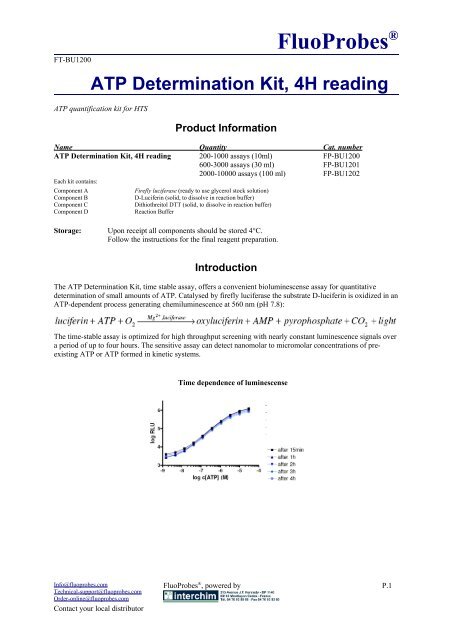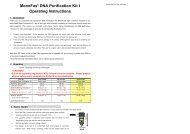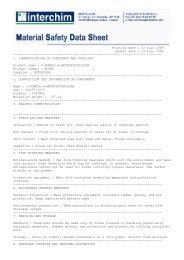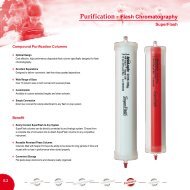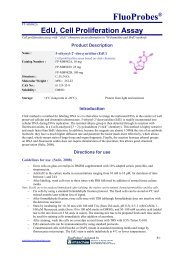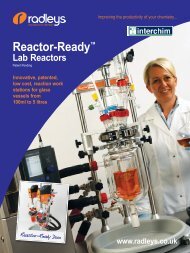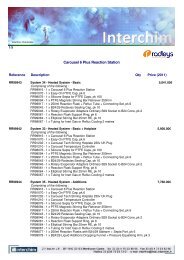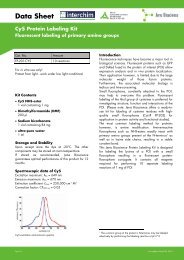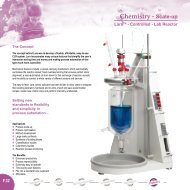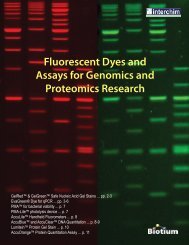FluoProbes® - Interchim
FluoProbes® - Interchim
FluoProbes® - Interchim
You also want an ePaper? Increase the reach of your titles
YUMPU automatically turns print PDFs into web optimized ePapers that Google loves.
FT-BU1200<br />
FluoProbes ®<br />
ATP Determination Kit, 4H reading<br />
ATP quantification kit for HTS<br />
Product Information<br />
Name Quantity Cat. number<br />
ATP Determination Kit, 4H reading 200-1000 assays (10ml) FP-BU1200<br />
600-3000 assays (30 ml) FP-BU1201<br />
2000-10000 assays (100 ml) FP-BU1202<br />
Each kit contains:<br />
Component A<br />
Component B<br />
Component C<br />
Component D<br />
Firefly luciferase (ready to use glycerol stock solution)<br />
D-Luciferin (solid, to dissolve in reaction buffer)<br />
Dithiothreitol DTT (solid, to dissolve in reaction buffer)<br />
Reaction Buffer<br />
Storage:<br />
Upon receipt all components should be stored 4°C.<br />
Follow the instructions for the final reagent preparation.<br />
Introduction<br />
The ATP Determination Kit, time stable assay, offers a convenient bioluminescense assay for quantitative<br />
determination of small amounts of ATP. Catalysed by firefly luciferase the substrate D-luciferin is oxidized in an<br />
ATP-dependent process generating chemiluminescence at 560 nm (pH 7.8):<br />
The time-stable assay is optimized for high throughput screening with nearly constant luminescence signals over<br />
a period of up to four hours. The sensitive assay can detect nanomolar to micromolar concentrations of preexisting<br />
ATP or ATP formed in kinetic systems.<br />
Time dependence of luminescense<br />
Info@fluoprobes.com<br />
Technical-support@fluoprobes.com<br />
Order-online@fluoprobes.com<br />
Contact your local distributor<br />
FluoProbes ® , powered by P.1
FT-BU1200<br />
FluoProbes ®<br />
Reagent Preparation (r)<br />
Directions for use<br />
• D-Luciferin stock solution: Add 500 μl of Reaction Buffer (Component D) to the D-Luciferin<br />
(Component B) and mix gently to dissolve the D-Luciferin completely. This D-Luciferin stock solution should<br />
be protected from light and is reasonable stable for several days at 4°C.<br />
• DTT stock solution: Add 150 μl of Reaction Buffer (Component D) to Dithiothreitol (Component C) and<br />
dissolve it completely.<br />
• The final reagent mix is prepared of 9850 μl Reaction Buffer (Component D), 100 μl DTT stock solution, 40 μl<br />
D-Luciferin stock solution and 10 μl Luciferase (Component A, only small volume, please centrifuge shortly if<br />
complete volume is not at the bottom of the vial). Mix solutions containing luciferase gently by inversion –<br />
vortex mixing may denature the enzyme.<br />
Note: you can improve the resulting luminescent signal by increasing the D-Luciferin concentration in the reagent by adding up to 400 μl of<br />
the D-Luciferin stock solution in 10 ml reagent, but this will cause a strong loss of signal stability during time, so time stable measurements<br />
can only be performed in less than one hour!<br />
• Make suitable aliquots and store them light protected until use at –20°C. Avoid repeated freezing and thawing.<br />
Guidelines for use<br />
• Thaw aliquot of final reagent mix and allow it to reach room temperature.<br />
• For 200 assay format add 50 μl of final reagent mix to 50 μl of ATP solution to be determined in a 96 or 384<br />
well plate optimised for luminescent reading; for 1000 assay format mix 10 μl of final reagent mix with 10 μl<br />
ATP solution. Other assay formats are possible, but take care that equal volumes of reagent and ATP solution are<br />
mixed.<br />
• The time stable luminescent signal can be measured preferably in a luminometer after 10 minutes to 4 hours at<br />
room temperature. Background luminescence can be subtracted if a blank assay was performed with buffer or<br />
pure water instead of an ATP containing solution.<br />
• Alternatively to a luminometer, a scintillation counter can be used to measure luciferase activity, too. Make a<br />
significant dilution (in 1x Reaction Buffer supplemented with 1mg/ml BSA) of the sample in a clear or<br />
translucent vial so that the sample completely covers the bottom of the vial (the sample can also be placed in a<br />
microfuge tube in the vial). Do not add scintillant! For a linear relationship between luciferase concentration and<br />
counts per minute (cpm), the coincidence circuit on the scintillation counter should be turned off. If it can not be<br />
turned off, you have to calculate the square root of measured cpm minus background cpm using a water or buffer<br />
blank ([sample-background] 1/2 ). The scintillation counter must be used in manual mode and should be read<br />
individually for 1-5 minutes each.<br />
• To determine the ATP concentrations, it is necessary to generate a standard curve for a series of defined ATP<br />
concentrations. For the determination of unknown ATP concentrations use reproducible experimental conditions<br />
(temperature, incubation times, assay volume, luminometer adjustments, etc.).<br />
• The time stable ATP Determination Kit is optimised for ATP concentrations ranging from 10 nM to 10 μM<br />
with a linear fit of the standard curve. Dilute higher ATP concentrations to obtain best results.<br />
Related products<br />
• ATP, 00064A • ATP Determination Kit, 0.1 to 100pM, FP-S2841A<br />
Ordering information<br />
Catalog size quantities and prices may be found at http://www.fluoprobes.com<br />
Please inquire for higher quantities (availability, shipment conditions).<br />
For any information, please ask : FluoProbes ® / <strong>Interchim</strong>; Hotline : +33(0)4 70 03 73 06<br />
Disclaimer : Materials from FluoProbes ® are sold for research use only, and are not intended for food, drug, household, or cosmetic use.<br />
FluoProbes ® is not liable for any damage resulting from handling or contact with this product.<br />
Rev.G06E/04vb<br />
Info@fluoprobes.com<br />
Technical-support@fluoprobes.com<br />
Order-online@fluoprobes.com<br />
Contact your local distributor<br />
FluoProbes ® , powered by P.2


